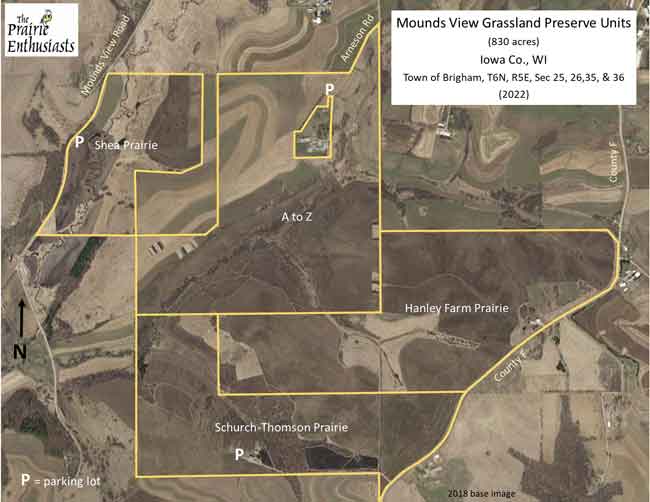
Mounds View Grassland
Mounds View Grassland is a 830-acre preserve of The Prairie Enthusiasts. TPE’s long-term goal for the site is to restore, as much as feasible, its original prairie, along with some limited oak savanna, and the associated wetlands and cold-water streams. The site was protected for its remnants of original prairie and the many rare and declining grassland plants, insects, amphibians, reptiles, and birds that inhabit the site. The preserve and surrounding open landscape provide excellent, critical habitat for rare and declining grassland birds. In addition, the preserve has cold-water streams, springs, seeps, and wetlands that add much to its biological diversity. There is also some oak savanna inhabited by red-headed woodpeckers and other birds, animals, and plants that require such habitat
ACCESS & DIRECTIONS
The Mounds View Grassland preserve is located south of US Highway 18/151 between Barneveld and Blue Mounds, Wisconsin. The properties are situated between County Highway F and Mounds View Rd. See site-specific pages for access points. Addresses are:
Schurch-Thomson Pr (8624 Reilly Rd, Barneveld)
Shea Pr (3095 Mounds View Road, Barneveld)
A to Z Farm (3200 Arneson Road, Barneveld)
Description & Significance
The preserve is significant for its remnant prairie vegetation and associated rare insects, and as wildlife habitat at both local and state levels, such as the Wisconsin-endangered/Federal Special Concern Species regal fritillary butterfly (Speyeria idalia) as well as many declining grassland bird species including bobolink, dickcissel, upland sandpiper, and Bell’s vireo. In fact, it may play a critical role in prairie ecosystem conservation in Wisconsin, for it lies within the 95,000+ acre Military Ridge Prairie Heritage Area (MRPHA). The MRPHA has been identified as the highest priority for landscape-scale grassland protection and management in Wisconsin by the Wisconsin Department of Natural Resources and represents one of the best opportunities in the Midwest to protect prairie remnants and area sensitive species. The agricultural history of the area has helped keep the landscape much as it was when the first settlers saw it (Figure 1) and has made it possible for plants and animals like grassland birds, which have disappeared in more developed parts of the Midwest, to survive. The Mounds View Prairie complex is one of the three most significant concentrations of prairie sod and grassland bird habitat within the MRPHA.
In addition to grassland plants, insect and birds, the site is home to many amphibian, reptilian and mammalian prairie species, including our state animal – the badger! Along with prairie and oak savanna habitats, the preserve has cold-water streams, springs, seeps, and wetlands that add much to its biological diversity.
The Prairie Enthusiast’s long-term goal for the Mounds View Grassland is to restore, as much as feasible, its original prairie, along with some limited oak savanna. It is also TPE’s intent to expand the preserve should opportunities arise.
The current cover on the 830-acre preserve is:
- 33% – Planted Prairie
- 26% – Non-Native Cool-Season Grass
- 13% – Active Cropland
- 10% – Remnant Prairie (not grazed)
- 8% – Woodland & Brush
- 5% – Wetland & Streams
- 3% – Savanna Restorations
- 3% – Pastured Remnant-Prairie Sod
Natural History
Mounds View lies near the eastern edge of Wisconsin’s driftless, or unglaciated, region. Its bedrock geology was formed 450-470 million years ago during the middle Ordovician period of the Paleozoic era. The Galena, Decorah and Platteville Formations remaining as dolomitic ridges rising 1150 feet above sea level surround the site, providing breathtaking panoramic views. The gently rolling hilltops of dolomite slope down to shallow valleys with the side slopes covered in St. Peter’s sandstone (Figure 2). The excavations of recently constructed badger dens can be observed in the easily excavated sandy soils. The St. Peter Sandstone is underlain by dolomitic rocks of the Prairie du Chien Group (Figure 3), which are not observable at Mounds View.
The Galena and Platteville Ordovician formations contain more fossils than any other geologic strata in Wisconsin. While stromatolites and oolites are lacking, the environment at the time was very hospitable to a broad range of bottom-dwelling, shell-forming animals such as brachiopods, bryozoans, corals, clams, and crinoids.
Plant List
Usage Policy
Allowed:
- Outdoor Recreation
- Hunting: Ring-Necked Pheasant (all seasons; no permit required)
- Hunting: Wild Turkey (all seasons; no permit required)
- Hunting: Waterfowl (all seasons; no permit required)
- Hunting: White Tailed Deer (bow, crossbow, muzzleloader; no permit required)
- Hunting: White Tailed Deer (Rifle, Shotgun; permit required)
Not Allowed:
Management
Some restoration work was begun in 2000, but most work has been done since 2007, after permanent protection began. In addition to planting prairie vegetation, approximately 59 acres have been cleared of dense trees and brush that had invaded the site over the previous 60 years. More clearing still needs to be done, along with additional weed control and planting of prairie seed. Restoration of the cold-water streams and wetlands began in 2012, with more worked planned.
There is still much to do, and it will take many decades to even begin to approach what the original ecosystems were like, but we are off to a very good start. It is also TPE’s intent to expand the preserve should opportunities arise.
The restoration and management work to date has been done mostly by volunteers and interns and aided by paid TPE land management staff and contractors paid for with grants from the US Fish & Wildlife Service, WI Department of Natural Resources, Wildlife Conservation Society, Paul E. Stry Foundation, Alliant Energy Foundation, and private donations.




